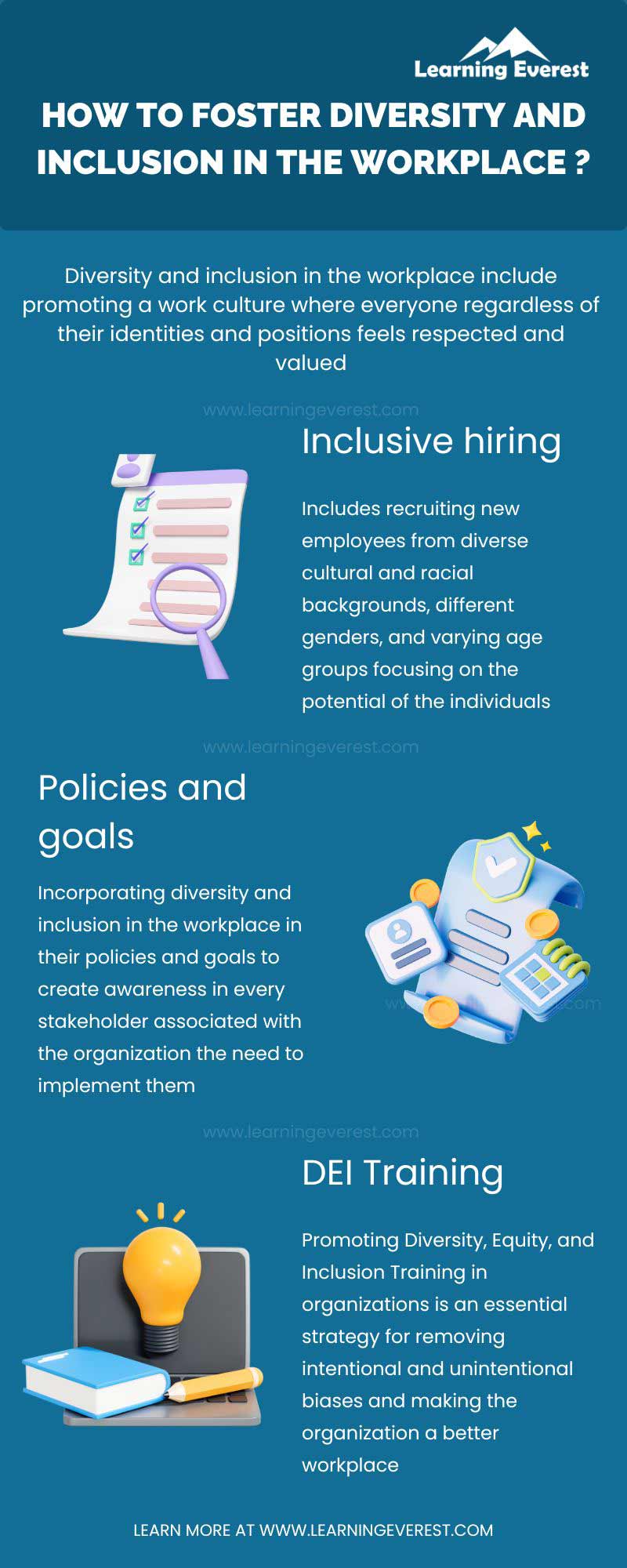Diversity and Inclusion in the workplace are the driving factors that guide an organization toward achieving fair and equal workforce representation. Diversity and inclusion in the workplace promote employees' sense of belonging, encompassing a global culture embracing differences. If you are looking for insights on what diversity and inclusion in the workplace are, why it is crucial to implement them, and how to foster a culture of diversity and inclusion in the workplace, carry on reading!
Table of Contents
- What is diversity and inclusion in the workplace?
- Why is it crucial to implement diversity and inclusion in the workplace?
- How to foster diversity and inclusion in the workplace?
- Conclusion
- Infographic
- Knowledge Check!
- Frequently Asked Questions (FAQs)
- What is diversity and inclusion in the workplace?
- Why is it important to incorporate diversity and inclusion in the workplace?
- How can organizations implement a culture of diversity and inclusion?
What is diversity and inclusion in the workplace?
The terms ‘diversity’ and ‘inclusion’ are two mutually complementing interconnected terms with a greater difference in their meanings. Diversity is the wide range of differences coexisting in a group or an organization. The differences can be based on age, gender, race, ethnicity, cultural background, disabilities, and socioeconomic status. In the workplace, diversity refers to a workforce consisting of individuals with varied backgrounds working together to achieve organizational goals. ‘Inclusion refers to an environment where everyone feels respected and valued, and has equal opportunities, regardless of their background or identity’ as per the definition given by Study.com. Inclusion in the workplace means nurturing a culture where all employees irrespective of their differences are valued and respected.
Diversity and inclusion in the workplace include promoting a work culture where everyone regardless of their identities and positions feels respected and valued. This means incorporating employees with differences across all positions from entry-level to top-tier management. Incorporating diversity and inclusion is necessary for the organization to yield positive outcomes. For instance, A LinkedIn study proved that companies with diversity and inclusion “were 22% more likely to be seen as an industry-leading company with high-caliber talent and 12% more likely to be seen as an inclusive workplace for people of diverse backgrounds.” With the growing concerns for equity among people, diversity and inclusion play a significant role in organizations nowadays.
Why is it crucial to implement diversity and inclusion in the workplace?
Organizations strive to adopt a diverse and inclusive environment by welcoming every talent and paying unbiased attention to the needs, ideas, and contributions of every employee. Promoting a workplace of diversity and inclusion is a top priority for organizations since it encourages equal participation leading to better outcomes. Here are some of the major reasons for creating a diverse and inclusive workplace.

Why is it Crucial to Implement Diversity and Inclusion in the Workplace
Improved productivity
Individuals with diverse identities contribute differently, with differences in their ideas and viewpoints. These varied contributions foster creativity and innovation in the teams leading to enhanced productivity. The LinkedIn study further found that ‘inclusive teams are over 35% more productive’ and ‘diverse teams make better decisions 87% of the time.’ Diverse teams with employees with differences in gender, culture, age, ethnicity, and race incorporate broader skills based on their experiences which gets reflected directly or indirectly in their inputs to the organization, thereby improving their performance and productivity.
Attracting new talent
A supportive work environment attracts job seekers before they intend to apply for a job. Organizations that promote a diverse and inclusive work environment are highly preferred as an ideal place to work by the employees. Many marginalized and underrepresented groups face discrimination in their workplaces even today making diversity and inclusion an indispensable factor when applying for jobs. A survey conducted by Glassdoor in 2020 among U.S. employees and jobseekers found that ‘about 4 in 5 Black (80%) Hispanic (80%) and LGBTQ (79%) job seekers and employees report a diverse workforce is an important factor when evaluating companies and job offers.’ This transparency around diversity and inclusion is important for attracting diverse talent.
Retention of existing talent
A workplace where employees feel valued improves the retention rate of the employees as they feel their contributions are rightly acknowledged and their ideas and innovations are promoted irrespective of a biased attitude. This inclusivity boosts job satisfaction of the employees leading to employee engagement and higher retention. A study by BetterUp found that ‘members with the highest levels of belonging have 34% higher intent to stay than those with low levels of belonging.’ Understanding diversity and promoting inclusion builds a sense of belonging in employees leading to higher retention.
Global Reputation
Diversity and inclusion in the workplace promote the employer branding of the organization and increase its market. With diversity in the work environment, it increases chances for wider acquiring of clients from various regions and cultures. Implementing these principles in the organization’s values improves the overall reputation creating a positive impact among its stakeholders.
Organizational profits
Diversity and inclusion have a vital role in improving the profitability of the organization. Improved innovation, employee engagement and retention, broader market, and financial outperformance as a result of an inclusive work environment contribute to profitability. This is illustrated in a report by Mckinsey suggesting that ‘companies in the top quartile for broad-gender diversity are 27 percent more likely to outperform financially’ and those with ‘ethnically diverse board are 13 percent more likely to outperform.’
Cross-cultural awareness
Employees, customers, and clients from diverse cultural backgrounds bring varied cultural perspectives to the workplace. This promotes an overall cross-cultural awareness in the organization leading to mutual acceptance and respect which is the need of the present era.
How to foster diversity and inclusion in the workplace?
Organizations emphasizing an inclusive culture of diverse perspectives adopt several steps to foster diversity and inclusion. To create a diverse and inclusive workplace, organizations can adopt three basic strategies.
Inclusive hiring
Inclusive hiring practice incorporating talents with diverse identities is a best practice for fostering diversity and inclusion in the workplace. This includes recruiting new employees from diverse cultural and racial backgrounds, different genders, and varying age groups. Most well-established organizations adopt the practice of inclusive hiring. To cite an example, Mastercard Inc., the American Multinational Corporation affirms that ‘69% of final candidate interviews include women’ and in the U.S., ‘86% of final interviews include a candidate of color.’ Such inclusive hiring focussed on the potential of the individuals can yield the best outputs to the employers.
Integration in policies and goals
Organizations can include diversity and inclusion in the workplace in their policies and goals to create awareness in every stakeholder associated with the organization the need to implement them. In recent years, many organizations have incorporated diversity into their mission and proposed goals based on inclusion. The software company Salesforce sets the goal of a ‘new multi-year global gender goal to reach 40% women-identifying and non-binary employees globally by the end of 2026.’
DEI Training
Promoting Diversity, Equity, and Inclusion Training in organizations is an essential strategy for removing intentional and unintentional biases and making the organization a better workplace. Through continuous training by adopting multiple channels of learning, employees benefit from harmonizing amidst diversities. The majority of the organizations are aware of the need for DEI training and adopt courses for the training. Microsoft Corporation, for instance, has included training courses like Inclusion and bias, Inclusion and allyship, and Inclusion and privilege in their training on Diversity and Inclusion.
Conclusion
Diversity and Inclusion in the Workplace aims to promote a work culture where everyone regardless of their positions and identities feels secure and valued. It is vital to incorporate diversity and inclusion principles in an organization because it results in improved productivity, attracts new employees, retains existing talent, provides a global reputation, organizational profits, and cross-cultural awareness. Organizations can nurture a culture of diversity and inclusion in the workplace by incorporating strategies like inclusive hiring, integration of diversity and inclusion in their policies and goals, and adopting Diversity, Equity, and Inclusion training. Workplaces can ensure diversity and inclusion and remove biases and discrimination for greater productivity.
Infographic
Knowledge Check!
Frequently Asked Questions (FAQs)
What is diversity and inclusion in the workplace?
Diversity and inclusion in the workplace include promoting a work culture where everyone regardless of their identities and positions feels respected and valued. This means incorporating employees with differences across all positions from entry-level to top-tier management. Incorporating diversity and inclusion is necessary for the organization to yield positive outcomes.
Why is it important to incorporate diversity and inclusion in the workplace?
It is vital to incorporate diversity and inclusion principles in an organization because it results in improved productivity, attracts new employees, retains existing talent, provides a global reputation, organizational profits, and cross-cultural awareness.
How can organizations implement a culture of diversity and inclusion?
Organizations can nurture a culture of diversity and inclusion in the workplace by incorporating strategies like inclusive hiring, integration of diversity and inclusion in their policies and goals, and adopting Diversity, Equity, and Inclusion training.






